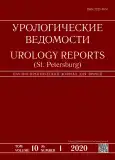A型肉毒杆菌毒素在多发性硬化症伴神经源性逼尿肌过度活动患者膀胱内注射100单位的临床疗效评价
- 作者: Filippova Е.S.1,2, Bazhenov I.V.1,2, Zyrjanov A.V.1,2, Zhuravlev V.N.1, Borzunov I.V.1, Ustinov G.S.1
-
隶属关系:
- Urals State Medical University of the Ministry of Healthcare of the Russian Federation
- Sverdlovsk Regional Clinical Hospital No. 1
- 期: 卷 10, 编号 1 (2020)
- 页面: 25-32
- 栏目: Original articles
- URL: https://journals.rcsi.science/uroved/article/view/17899
- DOI: https://doi.org/10.17816/uroved10125-32
- ID: 17899
如何引用文章
详细
研究现实性。A型肉毒杆菌毒素(A型肉毒杆菌毒素)经膀胱注射治疗神经原性下尿路功能障碍(NLUTD)患者逼尿肌多动症状的效果良好,推荐剂量为200和300单位。现有的强制医疗保险费率不包括逼尿肌内注射200单位药物的费用,而且经常迫使临床医生对特发性和神经性逼尿肌过度活跃的患者使用较低剂量(100单位)。
目的评价逼尿肌内注射100单位A型肉毒杆菌毒素对多发性硬化背景下神经原性下尿路功能障碍患者的疗效。
材料与方法。该研究包括28例神经源性逼尿肌过度活动的多发性硬化症患者,其对保守治疗有抵抗。所有患者均接受膀胱内注射100单位的A型肉毒杆菌毒素。在手术后1、3、6个月评估肉毒杆菌治疗的效果。结果。28例患者均取得临床改善。尿动力学研究显示,逼尿肌注射肉毒杆菌毒素3个月后,最大膀胱容积增加119.9±37.6%(p < 0.05),第一次逼尿肌不自主收缩时膀胱容积增加74.8 ± 21.4%(p < 0.05),亢进时最大逼尿肌压力减少53.5±29.7%(p < 0.05)。神经源性膀胱症状量表(NBSS)总分由38.04 ± 14.27降至29.06 ± 14.46(p = 0.000),主要原因为尿失禁和尿急。SF-Qualiveen总分从2.32 ± 0.70下降到1.61 ± 0.85(p = 0.000)。2例患者在肉毒杆菌治疗前进行了自我导尿,4例患者在手术后进行了自体导尿。
结论。在多发性硬化症背景下对NLUTD患者进行100单位A型肉毒神经毒素的逼尿肌内注射可改善尿动力学参数,这在6个月的随访中,患者的临床症状显著下降,生活质量提高。使用低剂量肉毒杆菌毒素不能完全缓解神经源性逼尿肌过度活动的症状,但导致只有7%的患者需要自我导尿。
作者简介
Еkaterina Filippova
Urals State Medical University of the Ministry of Healthcare of the Russian Federation; Sverdlovsk Regional Clinical Hospital No. 1
编辑信件的主要联系方式.
Email: filippova.cat@yandex.ru
ORCID iD: 0000-0003-3065-3953
SPIN 代码: 6364-8190
Candidate of Medical Sciences, Associate Professor of the Department of Urology; Urologist
俄罗斯联邦, EkaterinburgIgor Bazhenov
Urals State Medical University of the Ministry of Healthcare of the Russian Federation; Sverdlovsk Regional Clinical Hospital No. 1
Email: biv@okb1.ru
ORCID iD: 0000-0003-1745-700X
SPIN 代码: 7269-7282
Doctor of Medical Sciences, Professor of the Department of Urology; Head of the Urological Unit
俄罗斯联邦, EkaterinburgAleksandr Zyrjanov
Urals State Medical University of the Ministry of Healthcare of the Russian Federation; Sverdlovsk Regional Clinical Hospital No. 1
Email: zav1965@mail.ru
ORCID iD: 0000-0001-8105-7233
SPIN 代码: 6193-4204
Doctor of Medical Sciences, Professor. Chairman of the Department of Urology; Head of the Regional Urological Center of the Sverdlovsk Regional Clinical Hospital No. 1
俄罗斯联邦, EkaterinburgVladimir Zhuravlev
Urals State Medical University of the Ministry of Healthcare of the Russian Federation
Email: zhuravlev@okb1.ru
SPIN 代码: 7045-1956
Doctor of Medical Sciences, Professor
俄罗斯联邦, EkaterinburgIgor Borzunov
Urals State Medical University of the Ministry of Healthcare of the Russian Federation
Email: ivborzunov@e1.ru
ORCID iD: 0000-0002-9827-8451
SPIN 代码: 5502-4009
Doctor of Medical Sciences, Professor of the Department of Urology
俄罗斯联邦, EkaterinburgGennadiy Ustinov
Urals State Medical University of the Ministry of Healthcare of the Russian Federation
Email: GennadiyUstinov@mail.ru
ORCID iD: 0000-0002-4263-4568
SPIN 代码: 8423-8060
Student
俄罗斯联邦, Ekaterinburg参考
- Linsenmeyer TA. Use of botulinum toxin in individuals with neurogenic detrusor overactivity: state of the art review. J Spinal Cord Med. 2013;36(5):402-419. https://doi.org/10.1179/2045772313Y.0000000116.
- Montecucco C, Rossetto O, Caccin P, et al. Different mechanisms of inhibition of nerve terminals by botulinum and snake presynaptic neurotoxins. Toxicon. 2009;54(5):561-564. https://doi.org/10.1016/j.toxicon.2008.12.012.
- Schiavo G, Matteoli M, Montecucco C. Neurotoxins affecting neuroexocytosis. Physiol Rev. 2000;80(2):718-750. https://doi.org/10.1152/physrev.2000.80.2.717.
- Apostolidis A, Dasgupta P, Fowler CJ. Proposed mechanism for the efficacy of injected botulinum toxin in the treatment of human detrusor overactivity. Eur Urol. 2006;49(4):644-650. https://doi.org/10.1016/j.eururo.2005.12.010.
- Reitz A, Stohrer M, Kramer G, et al. European experience of 200 cases treated with botulinum-A toxin injections into the detrusor muscle for urinary incontinence due to neurogenic detrusor overactivity. Eur Urol. 2004;45(4):510-515. https://doi.org/10.1016/j.eururo.2003.12.004.
- Cruz F, Herschorn S, Aliotta P, et al. Efficacy and safety of onabotulinumtoxinA in patients with urinary incontinence due to neurogenic detrusor overactivity: a randomised, double-blind, placebo-controlled trial. Eur Urol. 2011;60(4):742-750. https://doi.org/10.1016/j.eururo.2011.07.002.
- Ginsberg D, Gousse A, Keppenne V, et al. Phase 3 efficacy and tolerability study of onabotulinumtoxinA for urinary incontinence from neurogenic detrusor overactivity. J Urol. 2012;187(6): 2131-2139. https://doi.org/10.1016/j.juro.2012.01.125.
- Cheng T, Shuang WB, Jia DD, et al. Efficacy and Safety of Onabotulinumtoxin A in patients with neurogenic detrusor overactivity: a systematic review and meta-analysis of randomized controlled trials. PLoS One. 2016;11(7): e0159307. https://doi.org/10.1371/journal.pone.0159307.
- Apostolidis A, Thompson C, Yan X, Mourad S. An exploratory, placebo-controlled, dose-response study of the efficacy and safety of onabotulinumtoxinA in spinal cord injury patients with urinary incontinence due to neurogenic detrusor overactivity. World J Urol. 2013;31(6):1469-1474. https://doi.org/10.1007/s00345-012-0984-0.
- Schurch B, de Seze M, Denys P, et al. Botulinum toxin type A is a safe and effective treatment for neurogenic urinary incontinence: results of a single treatment, randomized, placebo-controlled 6-month study. J Urol. 2005;174(1):196-200. https://doi.org/10.1097/01.ju.0000162035.73977.1c.
- Архиреев А.С., Ромих В.В., Пантелеев В.В., и др. Эффективность лечения больных нейрогенной и идиопатической детрузорной гиперактивностью в зависимости от дозы ботулинического токсина типа А // Экспериментальная и клиническая урология. – 2017. – № 3. – С. 98–103. [Arhireev AS, Romih VV, Panteleev VV, et al. The efficacy of therapy in patients with neurogenic and idiopathic detrusor hyperactivity depending on the dose of botulinum toxin type A. Experimental and clinical urology. 2017;(3):98-113. (In Russ.)]
- Mehnert U, Birzele J, Reuter K, Schurch B. The effect of botulinum toxin type A on overactive bladder symptoms in patients with multiple sclerosis: a pilot study. J Urol. 2010;184(3):1011-1016. https://doi.org/10.1016/j.juro.2010.05.035.
- Schurch B, de Seze M, Denys P, et al. Botulinum toxin type A is a safe and effective treatment for neurogenic urinary incontinence: results of a single treatment, randomized, placebo-controlled 6-month study. J Urol. 2005;174(1):196-200. https://doi.org/10.1097/01.ju.0000162035.73977.1c.
- Kalsi V, Popat RB, Apostolidis A, et al. Cost-consequence analysis evaluating the use of botulinum neurotoxin-A in patients with detrusor overactivity based on clinical outcomes observed at a single UK centre. Eur Urol. 2006;49(3):519-527. https://doi.org/10.1016/j.eururo.2005.11.006.
- Kalsi V, Gonzales G, Popat R, et al. Botulinum injections for the treatment of bladder symptoms of multiple sclerosis. Ann Neurol. 2007;62(2):452-457. https://doi.org/10.1002/ana.21209.
- Khan S, Game X, Kalsi V, et al. Long-term effect on quality of life of repeat detrusor injections of botulinum neurotoxin-A for detrusor overactivity in patients with multiple sclerosis. J Urol. 2011;185(4): 1344-1349. https://doi.org/10.1016/j.juro.2010.12.002.
- Koschorke M, Leitner L, Sadri H, et al. Intradetrusor onabotulinumtoxinA injections for refractory neurogenic detrusor overactivity incontinence: do we need urodynamic investigation for outcome assessment? BJU Int. 2017;120(6):848-854. https://doi.org/10.1111/bju.13976.
补充文件







